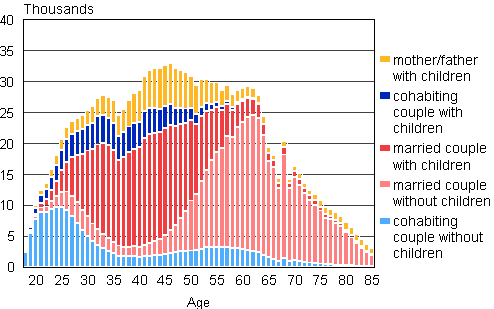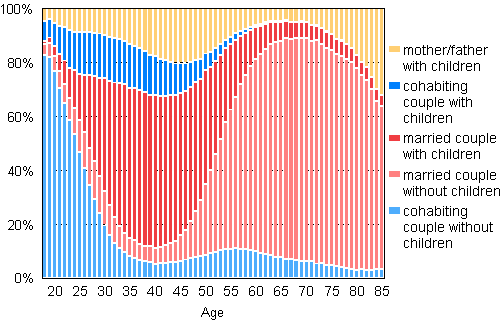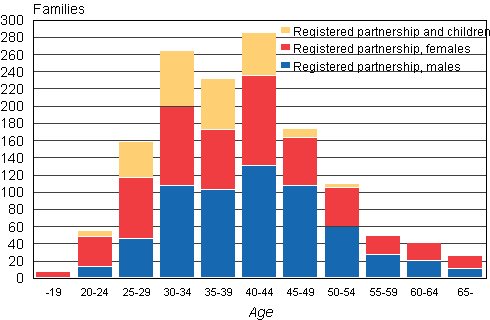1. Commonest type of family in Finland is married couple without children
Families are classified according to whether the spouses are married, cohabiting or in a registered partnership and whether they have children. In addition to these, one-parent families form a class of their own. In this classification, no limit is set on the age of a child. Chapter 3 elaborates on families with underage children, defined as families having at least one child under the age of 18 living at home. In connection with families with underage children parents are also referred to as supporters. In the following study, one-parent families are not only single-supporter families, as a person having the status of a child living with his/her mother or father may be of any age. In the present statistics, the oldest person classified in the category of child is 79 years old.
At the end of 2009 there were 1,450,000 families in Finland. Their number grew by 6,100 from the year before. The increase was somewhat smaller than in the previous year
Altogether 76 per cent of the Finnish population belong to a family. The proportion fell by 0.2 percentage points from the previous year. The rate of decrease has remained at this level since the beginning of the 1990s. The proportion of family population was at its highest in the 1960s and 1970s, when 87 per cent of the population belonged to a family. The number of persons belonging to a family increased by 7,800 during 2009. The total population increased by 25,100 persons. At the end of 2009, the average size of a family was 2.8 persons.
Table 1. Family population and average size of family in 1950–2009
| Year | Families total | Family population | Population | Proportion of family population, % | Average size of family |
| 1950 | 930 572 | 3 457 474 | 4 029 803 | 85,8 | 3,7 |
| 1960 | 1 036 270 | 3 855 037 | 4 446 222 | 86,7 | 3,7 |
| 1970 | 1 153 878 | 3 986 005 | 4 598 336 | 86,7 | 3,5 |
| 1980 | 1 278 102 | 4 023 091 | 4 787 778 | 84,0 | 3,1 |
| 1990 | 1 365 341 | 4 101 922 | 4 998 478 | 82,1 | 3,0 |
| 2000 | 1 401 963 | 4 053 850 | 5 181 115 | 78,2 | 2,9 |
| 2005 | 1 426 002 | 4 037 753 | 5 255 580 | 76,8 | 2,8 |
| 2006 | 1 431 376 | 4 039 944 | 5 276 955 | 76,6 | 2,8 |
| 2007 | 1 437 709 | 4 045 561 | 5 300 484 | 76,3 | 2,8 |
| 2008 | 1 444 386 | 4 051 662 | 5 326 314 | 76,1 | 2,8 |
| 2009 | 1 450 488 | 4 059 511 | 5 351 427 | 75,9 | 2,8 |
The commonest type of family in Finland is married couple without children Thirty-five per cent of all families fell into this category in 2009. As recently as in 2004, the most common family type in Finland was married couple with children of some age living at home with them. In 2009, 31 per cent of all families consisted of a married couple with children. The number of such families has been on the decline for a long time, whereas the number of married couples without children has been rising. The number of married couples living with their children fell by 3,300 from the previous year. This decrease was slightly smaller than in the previous year.
Reasons for the falling number of married couples living with their children can be sought from a number of directions. The rising divorce rate has decreased the number of married couples. The housing conditions of the young have also improved lately and young people leave their parents' home earlier than they used to. On the other hand, there are fewer new married couples with children, as the age groups forming families are small nowadays and couples often favour cohabitation.
What, then, explains the increased number of married couples without children? The large, post-war age groups are at an age when their children have left home and the parents have fallen into a new category in family statistics, i.e. that of married couples without children. The difference between married couples without children and married couples with children is, however, still small.
The number and proportion of cohabiting couples among families is also growing. However, cohabiting couples without children make up only 13 per cent of all families. Today, eight per cent of all families are cohabiting couples with children. Their number is rising as well.
The number of “mother and children” families has declined now for the tenth consecutive year. “Father and children” families are still rare; they number only two in one hundred. Their relative proportion has not changed much over the past few years.
Table 2. Families by type in 1950–2009 by year and family type
| Year | Total | Maried couple without children | Married couple with children | Cohabitin couple without children | Cohabiting couple with children | Mother and children | Father and children | Registered male couple 1) | Registered female couple 1) |
| 1950 | 930 572 | 176 650 | 593 763 | .. | .. | 137 803 | 22 356 | .. | .. |
| 1960 | 1 036 270 | 207 897 | 678 822 | .. | .. | 129 706 | 19 845 | .. | .. |
| 1970 2) | 1 153 878 | 260 562 | 722 001 | 6 800 | 19 100 | 126 394 | 19 021 | .. | .. |
| 1980 3) | 1 278 102 | 302 818 | 711 226 | 36 200 | 65 900 | 140 725 | 21 233 | .. | .. |
| 1990 | 1 365 341 | 364 452 | 640 062 | 65 896 | 123 471 | 147 297 | 24 161 | .. | .. |
| 2000 | 1 401 963 | 436 019 | 514 868 | 102 581 | 160 132 | 159 432 | 28 931 | .. | .. |
| 2001 | 1 407 759 | 446 404 | 501 981 | 105 399 | 166 601 | 158 440 | 28 934 | .. | .. |
| 2002 | 1 411 947 | 454 977 | 492 524 | 107 443 | 170 368 | 157 143 | 29 093 | 207 | 192 |
| 2003 | 1 415 104 | 462 561 | 483 140 | 109 672 | 174 144 | 156 235 | 29 352 | 271 | 275 |
| 2004 | 1 420 781 | 471 962 | 475 705 | 111 294 | 177 095 | 154 851 | 29 192 | 325 | 357 |
| 2005 | 1 426 002 | 481 209 | 468 266 | 112 847 | 180 590 | 153 024 | 29 238 | 398 | 430 |
| 2006 | 1 431 376 | 488 880 | 461 569 | 114 671 | 184 732 | 151 475 | 29 101 | 455 | 493 |
| 2007 | 1 437 709 | 496 814 | 456 235 | 115 860 | 188 172 | 150 251 | 29 288 | 527 | 562 |
| 2008 | 1 444 386 | 504 728 | 452 180 | 115 966 | 191 177 | 149 631 | 29 460 | 579 | 665 |
| 2009 | 1 450 488 | 509 916 | 448 897 | 116 797 | 193 894 | 149 823 | 29 765 | 625 | 771 |
| % | |||||||||
| 1950 | 100,0 | 19,0 | 63,8 | .. | .. | 14,8 | 2,4 | .. | .. |
| 1960 | 100,0 | 20,1 | 65,5 | .. | .. | 12,5 | 1,9 | .. | .. |
| 1970 2) | 100,0 | 22,6 | 62,6 | 0,6 | 1,7 | 11,0 | 1,6 | .. | .. |
| 1980 3) | 100,0 | 23,7 | 55,6 | 2,8 | 5,2 | 11,0 | 1,7 | .. | .. |
| 1990 | 100,0 | 26,7 | 46,9 | 4,8 | 9,0 | 10,8 | 1,8 | .. | .. |
| 2000 | 100,0 | 31,1 | 36,7 | 7,3 | 11,4 | 11,4 | 2,1 | .. | .. |
| 2001 | 100,0 | 31,7 | 35,7 | 7,5 | 11,8 | 11,3 | 2,1 | .. | .. |
| 2002 | 100,0 | 32,2 | 34,9 | 7,6 | 12,1 | 11,1 | 2,1 | 0,0 | 0,0 |
| 2003 | 100,0 | 32,7 | 34,1 | 7,8 | 12,3 | 11,0 | 2,1 | 0,0 | 0,0 |
| 2004 | 100,0 | 33,2 | 33,5 | 7,8 | 12,5 | 10,9 | 2,1 | 0,0 | 0,0 |
| 2005 | 100,0 | 33,7 | 32,8 | 7,9 | 12,7 | 10,7 | 2,1 | 0,0 | 0,0 |
| 2006 | 100,0 | 34,2 | 32,2 | 8,0 | 12,9 | 10,6 | 2,0 | 0,0 | 0,0 |
| 2007 | 100,0 | 34,6 | 31,7 | 8,1 | 13,1 | 10,5 | 2,0 | 0,0 | 0,0 |
| 2008 | 100,0 | 34,9 | 31,3 | 8,0 | 13,2 | 10,4 | 2,0 | 0,0 | 0,0 |
| 2009 | 100,0 | 35,2 | 30,9 | 8,1 | 13,4 | 10,3 | 2,1 | 0,0 | 0,1 |
2) The breakdown of the census by type of family has been revised on the basis of interview surveys. (Aromaa, Cantell & Jaakkola: Avoliitto (Consensual Union), Research Institute of Legal Policy 49, Helsinki 1981).
3) The breakdown of the census by type of family has been revised on the basis of the 1981 register-based material on families and cohabiting couples.
1.1 Type of family varies by stage of life
Women’s types of families vary at different stages of life. The type of family of young women aged under 28 with a family is typically married couple without children. The most typical family type for 28-year-old women is already “married couple with children”. Only for women aged 52 or older the most typical family type is “married couple without children.” Families of the oldest women (at least 89 years of age) tend to include a child rather than a husband. Only nine per cent of women of this age still belong to the family population. In the light of family statistics, old age is rather different for men. For example, 45 per cent of men aged over 89 belong to families. Their typical family type then is married couple without children living with them.
Figure 1A. Families by type and age of wife/mother in 2009 (families with father and children by age of father)

Figure 1B. Families by type and age of wife/mother in 2009 (families with father and children by age of father), relative breakdown

1.2 Male couples are older than female couples
At the end of 2009, 625 male couples and 771 female couples lived in a registered partnership, which was a total of 152 couples more than in 2008. These families are presented in the group of married couples in the majority of the tables in this publication. In some of the tables on the whole country these families form a group of their own. For reasons of data protection, the information can be given by municipality only if the number of couples is at least five. Figure 2 shows the age distribution of registered male and female couples according to the younger partner. It shows that male couples are older than female couples. In the other figures registered couples are given among married couples. There are still so few of them that they would not be visible as a separate group.
Figure 2. Registered partnerships by age of younger partner in 2009

1.3 Cohabiting at young age - marrying later
Cohabitation is the form of family life chosen by young couples without children. Up to the age of 40, women without children tend to prefer cohabitation to marriage. Where mothers are concerned, the only ones to favour cohabitation over marriage are in the small group of mothers aged under 25. The majority of mothers older than this living with their spouses are married. The older the woman, the more likely she is to be married to her spouse.
Married couples account for 66 per cent of all families and for 75 per cent of all married and cohabiting couples. Cohabiting couples make up 21 per cent of all families. Of the families consisting of spouses living together, 24 per cent are cohabiting couples.
In 83 per cent of all married couples both spouses are married for the first time. Thus the conventional form of family can still be considered to prevail in Finland. In 67 per cent of the cohabiting couples neither spouse had been previously married. Hence, on the average, there are clearly more couples where one of the spouses has been married before among cohabiting couples than among married couples.
In 85 per cent of the registered male couples neither partner has been married before, the figure for female couples is 74 per cent.
1.4 Fathers of families of cohabiting couples are unmarried more often than mothers
In the past, a person's marital status revealed quite a lot about his or her family. Today, hardly any conclusions can be drawn from a person’s marital status. In the Nordic Countries, marital status is losing meaning as a demographic variable.
Seventy-four per cent of the women and 75 per cent of the men living in a cohabiting partnership without children are unmarried. More cohabiting women than cohabiting men are widows.
Slightly more of the men than of the women living with children and a cohabiting partner are unmarried. Correspondingly, fewer of the men than of the women are divorced. The probable explanation to this is reconstituted families where a new partner has moved in to live with a divorced mother. There are also slightly more widows among cohabiting mothers than among cohabiting fathers.
Table 3. Marital status of the man/woman/father/mother in a cohabiting partnership and in a one-parent family in 2009
| Marital status | Type of family | |||||||
| Cohabiting man no children | Cohabiting woman no children | Cohabiting man with children | Cohabiting woman with children | Father and children | Father and children aged under 18 | Mother and children | Mother and children aged under 18 | |
| Unmarried | 75,0 | 73,9 | 78,1 | 76,8 | 17,4 | 26,0 | 31,1 | 40,6 |
| Married | 0,8 | 0,7 | 0,4 | 0,5 | 12,6 | 14,2 | 9,6 | 11,8 |
| Divorced | 22,4 | 21,2 | 20,8 | 21,3 | 52,1 | 53,7 | 42,8 | 44,6 |
| Widowed | 1,8 | 4,2 | 0,6 | 1,4 | 17,8 | 6,1 | 16,5 | 3,1 |
| Total | 100,0 | 100,0 | 100,0 | 100,0 | 100,0 | 100,0 | 100,0 | 100,0 |
| N | 193 856 | 193 851 | 116 788 | 116 786 | 29 752 | 15 547 | 149 738 | 102 088 |
Mothers and fathers in one-parent families also differ in their marital status. More than half of the fathers but clearly fewer of the mothers are divorced. Altogether, 31 per cent of the mothers but only 17 per cent of the fathers are unmarried. It should be noted here that no limit is set on the age of a child, i.e. we are not referring to single supporters. The child of a one-parent family can be of any age, meaning that families formed by old widowed mothers and their grown-up children, for example, are included.
Table 3 also contains columns for families formed of one supporter and underage children, that is, fathers and mothers with underage children. Their marital status structure differs most clearly from the group of all one-parent families. They include fewer widowed persons and more persons representing other marital status groups. It is worth noting that relatively almost twice as many fathers as mothers of single-supporter families are widowed, although fewer fathers than mothers become widowed. In divorces, children usually stay with their mother, but there is no choice in the case of death. Already as many as 41 per cent of the mothers of single-supporter families are unmarried; some having been single supporters from the outset but a larger number as the result of a divorce.
Source: Population and Cause of Death Statistics, Statistics Finland
Inquiries: Marjut Pietiläinen (09) 1734 2798, Timo Nikander (09) 1734 3250, vaesto.tilasto@stat.fi
Director in charge: Jari Tarkoma
Updated 30.11.2010
Official Statistics of Finland (OSF):
Families [e-publication].
ISSN=1798-3231. Annual Review 2009,
1. Commonest type of family in Finland is married couple without children
. Helsinki: Statistics Finland [referred: 18.12.2025].
Access method: http://stat.fi/til/perh/2009/02/perh_2009_02_2010-11-30_kat_001_en.html

